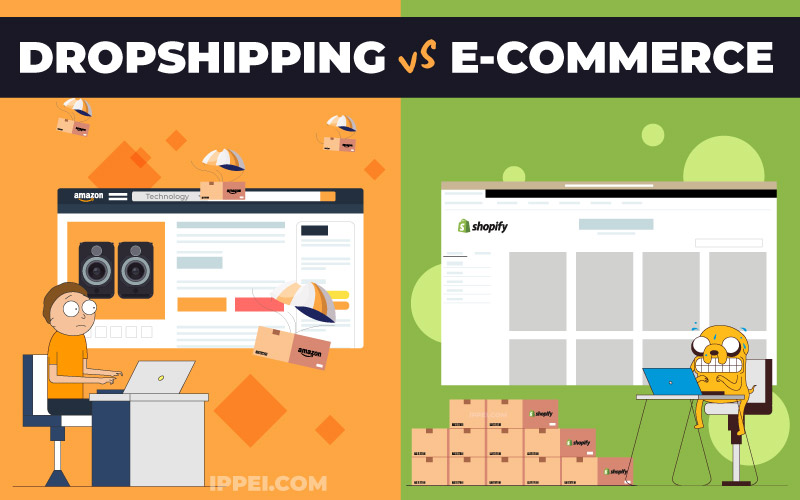Should you open an online shop and handle your own shipping, inventory, and costs? Or use dropshipping to get your foot in the door of the online business world?
It’s possible that customers won’t be able to tell the difference between buying from a regular e-commerce site and a dropshipping site. Here are the most important differences between dropshipping and ecommerce to help you decide which is best for your site.
What Is Online Shopping?
Ecommerce, which stands for “electronic commerce,” is when people buy and sell goods and services online through websites, mobile apps, or online markets. Ecommerce businesses come in many shapes and sizes. Some examples are stores that sell real goods, companies that make digital goods that can be downloaded, and service providers that offer their services online.
With an ecommerce shop, an online business can reach customers from far away and be open 24 hours a day, seven days a week. It also makes online shopping easy by offering features like online transfers, order tracking, and customer service.
What Does Dropshipping Mean?
Dropshipping is an e-commerce way for fulfilling orders where you don’t keep the goods you sell in stock. When a customer makes an order, you send it to a third-party supplier instead. That supplier ships the product straight to the customer.
You, as the store owner, act as a go-between for the customer and the seller. With dropshipping, you can open an online store without having to buy goods or deal with complicated logistics.
Dropshipping is an e-commerce approach in which you give third-party suppliers control of your inventory and shipping. You could sell some items the old-fashioned way and drop-ship others. To upsell and raise the average order value, you could, for example, make your own manual coffee grinders and export branded beans.
Differences Between Dropshipping & Ecommerce Inventory Management
For e-commerce to work, you need to buy goods in bulk, store and manage your inventory, and either fill orders yourself or use a fulfillment center. It costs money at first, but it gives you full power over your inventory and shipping.
Dropshipping lets you sell things without having to keep them in stock. Orders are sent to wholesalers, who then ship directly to customers. This lowers the cost of getting started, but it also means that you have less control over the products you offer and when they ship.
Margins of Profit
Ecommerce usually lets you make a lot of money because you can buy things in bulk and set your own prices for store sales.
When you drop-ship, your profit margins are usually smaller because the sellers take a big cut. Drop-shipping sellers charge more for their goods, so there is less room for markup.
Controlling The Quality Of The Goods
Ecommerce gives you a lot of control over the quality of the products you sell because you can check your goods and make sure they meet standards before selling them.
You have less control over the quality of the products you drop-ship because you depend on your providers to meet standards, which can be different.
Sending And Receiving Items
When you handle shipping and fulfillment in-house for e-commerce, you have full control over the methods of delivery, prices, and wait times. You can talk to companies about rates and make sure packages are sent quickly.
When you drop-ship, your supplier handles shipping and fulfillment. This means you don’t have to manage logistics as much, but you still have control over shipping speed and customer happiness.
Making Brands And Changes
- Ecommerce: It’s easy to change a lot of things about a brand’s look and feel, from the package to the inserts that are personalized. This creates a unique brand experience.
- Dropshipping: Branding is limited to online store customization because goods often come in generic packaging from suppliers, making it harder to stand out.
Help with Customers
- Ecommerce: Having direct power over customer service lets you provide personalized help and handle returns and exchanges quickly, but you need a special system to make this happen.
- Dropshipping: It can be harder to help customers because you have to work with your providers to solve problems, which could cause delays and less satisfied customers.
How to Scale
- Ecommerce: It can grow a lot with more inventory and more activities, which can help with better margins and buying in bulk, but it needs a lot of money to get started.
- Dropshipping lets you grow or shrink your business without having to buy goods up front, but it’s limited by the suppliers’ availability and capacity.
Race to Win
Ecommerce can use unique goods and brand identity to cut down on direct competition, but it needs to keep researching and developing the market.
Many dropshippers get their goods from the same sellers, so there is a lot of price competition. Marketing and good customer service are what set dropshippers apart.
In conclusion
Which one you choose relies on the goals and resources of your business, as well as how much control you want over inventory, quality, and customer service. Each model has pros and cons, and the best way to run your online store will depend on your wants and the situation you’re in.



